Assessing High-Voltage Shore Connection Safety: An In-Depth Study of Grounding Practices in Shore Power Systems
Abstract
:1. Introduction
2. HVSC Grounding System Requirements
2.1. HVSC System Framework
2.2. HVSC Grounding (Earthing) System
3. Safety Voltage Assessment in HVSC
3.1. Body Resistance and Permissible Current
3.2. Shock Model and Permissible Voltage
3.3. Phase to Ground Fault Current
- Symmetrical Components Method
3.4. Assessment Method
4. Case Study of Kaohsiung Harbor
4.1. HVSC Systems of Kaohsiung Harbor
4.2. Permissible Touch and Step Voltage
4.3. Actual Touch Voltage in Case Study
5. Conclusions and Recommendations
- Direct electric shocks in HVSC systems can cause touch voltages that exceed international safety limits, regardless of NGR specifications or equipotential bonding. To reduce this risk, the strict prohibition of direct contact within the HVSC system, use of insulating protective gear by operators, and installation of an NGR at the shore-side transformer’s neutral point are essential for safety and compliance with international standards.
- Using HRG and a PEN conductor in HVSC systems keeps indirect shock voltages within safe limits, ensuring compliance with standards. However, with LGR, there is a risk of arcing and minor exceedances of safe voltage limits on ship decks. To improve safety, the careful selection of neutral protection relays and proper personal protective equipment is crucial for maintaining operational safety within acceptable voltage limits.
- It is crucial to continuously monitor and maintain equipotential bonding to prevent direct and indirect contact voltages from exceeding international standards, regardless of the grounding method used. Adhering to IEC/IEEE 80005-1 regulations for monitoring equipotential connections ensures safety and reduces electrical hazards.
- The findings of this study indicate that moisture levels in dock concrete surfaces have a minimal impact on contact voltages. The key determinants of safety are the proper installation of the NGR and the maintenance of an intact PEN conductor.
Author Contributions
Funding
Data Availability Statement
Conflicts of Interest
References
- Wang, X.; Du, D.; Peng, Y. Assessing the Importance of the Marine Chokepoint: Evidence from Tracking the Global Marine Traffic. Sustainability 2023, 16, 384. [Google Scholar] [CrossRef]
- Abu Bakar, N.N.; Bazmohammadi, N.; Vasquez, J.C.; Guerrero, J.M. Electrification of onshore power systems in maritime transportation towards decarbonization of ports: A review of the cold ironing technology. Renew. Sustain. Energy Rev. 2023, 178, 113243. [Google Scholar] [CrossRef]
- Song, M.-J.; Seo, Y.-J.; Lee, H.-Y. The dynamic relationship between industrialization, urbanization, CO2 emissions, and transportation modes in Korea: Empirical evidence from maritime and air transport. Transportation 2022, 50, 2111–2137. [Google Scholar] [CrossRef]
- Zhong, Q.; Shen, H.; Yun, X.; Chen, Y.; Ren, Y.; Xu, H.; Shen, G.; Du, W.; Meng, J.; Li, W.; et al. Global Sulfur Dioxide Emissions and the Driving Forces. Environ. Sci. Technol. 2020, 54, 6508–6517. [Google Scholar] [CrossRef]
- Chen, D.; Fu, X.; Guo, X.; Lang, J.; Zhou, Y.; Li, Y.; Liu, B.; Wang, W. The impact of ship emissions on nitrogen and sulfur deposition in China. Sci. Total Environ. 2019, 708, 134636. [Google Scholar] [CrossRef]
- Aakko-Saksa, P.T.; Lehtoranta, K.; Kuittinen, N.; Järvinen, A.; Jalkanen, J.-P.; Johnson, K.; Jung, H.; Ntziachristos, L.; Gagné, S.; Takahashi, C.; et al. Reduction in greenhouse gas and other emissions from ship engines: Current trends and future options. Prog. Energy Combust. Sci. 2023, 94, 101055. [Google Scholar] [CrossRef]
- Yin, M.; Wang, Y.; Zhang, Q. Policy implementation barriers and economic analysis of shore power promotion in China. Transp. Res. Part D Transp. Environ. 2020, 87, 102506. [Google Scholar] [CrossRef]
- Chen, J.; Zheng, T.; Garg, A.; Xu, L.; Li, S.; Fei, Y. Alternative Maritime Power application as a green port strategy: Barriers in China. J. Clean. Prod. 2018, 213, 825–837. [Google Scholar] [CrossRef]
- Wang, W.; Wang, S.; Zhen, L. Optimal subsidy design for energy generation in ship berthing. Marit. Policy Manag. 2023, 1–14. [Google Scholar] [CrossRef]
- Zis, T.P. Prospects of cold ironing as an emissions reduction option. Transp. Res. Part A Policy Pract. 2018, 119, 82–95. [Google Scholar] [CrossRef]
- Nguyen, D.-H.; Lin, C.; Cheruiyot, N.K.; Hsu, J.-Y.; Cho, M.-Y.; Hsu, S.-H.; Yeh, C.-K. Reduction of NOx and SO2 Emissions by Shore Power Adoption. Aerosol Air Qual. Res. 2021, 21, 210100. [Google Scholar] [CrossRef]
- Koričan, M.; Frković, L.; Vladimir, N. Electrification of fishing vessels and their integration into isolated energy systems with a high share of renewables. J. Clean. Prod. 2023, 425, 138997. [Google Scholar] [CrossRef]
- Colarossi, D.; Principi, P. Optimal sizing of a photovoltaic/energy storage/cold ironing system: Life Cycle cost approach and environmental analysis. Energy Convers. Manag. 2023, 291, 117255. [Google Scholar] [CrossRef]
- Perčić, M.; Vladimir, N.; Koričan, M. Electrification of Inland Waterway Ships Considering Power System Lifetime Emissions and Costs. Energies 2021, 14, 7046. [Google Scholar] [CrossRef]
- Frković, L.; Ćosić, B.; Pukšec, T.; Vladimir, N. The synergy between the photovoltaic power systems and battery-powered electric ferries in the isolated energy system of an island. Energy 2022, 259, 124862. [Google Scholar] [CrossRef]
- Abu Bakar, N.N.; Bazmohammadi, N.; Çimen, H.; Uyanik, T.; Vasquez, J.C.; Guerrero, J.M. Data-driven ship berthing forecasting for cold ironing in maritime transportation. Appl. Energy 2022, 326, 119947. [Google Scholar] [CrossRef]
- Williamsson, J.; Costa, N.; Santén, V.; Rogerson, S. Barriers and Drivers to the Implementation of Onshore Power Supply—A Literature Review. Sustainability 2022, 14, 6072. [Google Scholar] [CrossRef]
- Radwan, M.E.; Chen, J.; Wan, Z.; Zheng, T.; Hua, C.; Huang, X. Critical barriers to the introduction of shore power supply for green port development: Case of Djibouti container terminals. Clean Technol. Environ. Policy 2019, 21, 1293–1306. [Google Scholar] [CrossRef]
- IEEE/IEC 80005-1; IEEE/IEC IEC/IEEE International Standard—Utility Connections in Port—Part 1: High Voltage Shore Connection (HVSC) Systems—General Requirements. International Organization for Standardization: Geneva, Switzerland, 2019.
- Paul, D.; Chavdarian, P.R. System Capacitance and Its Effects on Cold Ironing Power System Grounding. In Proceedings of the 2006 IEEE Industrial and Commercial Power Systems Technical Conference—Conference Record, Las Vegas, NV, USA, 30 May 2006; pp. 1–11. [Google Scholar]
- Paul, D.; Peterson, K.; Chavdarian, P.R. Designing Cold Ironing Power Systems: Electrical Safety During Ship Berthing. IEEE Ind. Appl. Mag. 2014, 20, 24–32. [Google Scholar] [CrossRef]
- IEC 60909-0; Short-Circuit Currents in Three-Phase a.c. Systems—Part 0: Calculation of Currents. International Organization for Standardization: Geneva, Switzerland, 2016.
- IEC 61363-1; Electrical Installations of Ships and Mobile and Fixed Offshore Units—Part 1: Procedures for Calculating Short-Circuit Currents in Three-Phase a.c. International Organization for Standardization: Geneva, Switzerland, 1998.
- D’Agostino, F.; Grillo, S.; Infantino, R.; Pons, E. High-Voltage Shore Connection Systems: Grounding Resistance Selection and Short-Circuit Currents Evaluation. IEEE Trans. Transp. Electrif. 2021, 8, 2608–2617. [Google Scholar] [CrossRef]
- Feng, Y.; Ningzhao, L.; Jing, H.; Benxiang, W. Research on step voltage of medium voltage shore power system near fault location. In Proceedings of the 2015 IEEE Advanced Information Technology, Electronic and Automation Control Conference (IAEAC), Chongqing, China, 19–20 December 2015; pp. 1005–1009. [Google Scholar]
- Parise, G.; Parise, L.; Malerba, A.; Sabatini, S.; Chavdarian, P.; Su, C.-L. High Voltage Shore Connections (HVSC), an IEC/ISO/IEEE 80005-1 Compliant Solution: The Neutral Grounding System. In Proceedings of the 2016 IEEE Industry Applica-tions Society Annual Meeting, Portland, OR, USA, 2 October 2016; pp. 1–6. [Google Scholar]
- Parise, G.; Lamedica, R.; Martirano, L.; Ruvio, A.; Parise, L.; Chavdarian, B.; Su, C.-L. TN-Grounding Systems for the Emerging Cold Ironing: Multiple Grounded System vs Island System. In Proceedings of the 2018 IEEE International Conference on Environment and Electrical Engineering and 2018 IEEE Industrial and Commercial Power Systems Europe (EEEIC/I&CPS Europe), Palermo, Italy, 12 June 2018; pp. 1–6. [Google Scholar]
- Kozak, M.; Chmiel, J. Cold Ironing Galvanic Corrosion Issues with Regard to a Shore-to-Ship Medium Voltage Connection. Energies 2020, 13, 5372. [Google Scholar] [CrossRef]
- Mehammer, E.B.; Kongstein, O.E.; Brede, A.P. Grounding Strategies for High Voltage Shore Connection of Large Passenger Vessels. In Proceedings of the 2018 IEEE International Conference on Environment and Electrical Engineering and 2018 IEEE Industrial and Commercial Power Systems Europe (EEEIC/I&CPS Europe), Palermo, Italy, 12 June 2018; pp. 1–6. [Google Scholar]
- Sulligoi, G.; Bosich, D.; Baldi, R.; Tosato, F. Limiting Hull Touch Voltages in Large Power Shore Connection Systems during Phase-to-Ground Faults: A Solution Proposal. In Proceedings of the 2013 IEEE Electric Ship Technologies Symposium (ESTS), Arlington, VI, USA, 22 April 2013; pp. 337–341. [Google Scholar]
- Lv, Y.; Cao, X.; Zhou, Q.; Zhao, W.; Ding, K. Safety and Security Study for Shore Power System: State-of-the-Art. In Proceedings of the 2020 IEEE International Conference on Industrial Engineering and Engineering Management (IEEM), Singapore, 14 December 2020; pp. 1306–1310. [Google Scholar]
- Paul, P.E.D.; Chavdarian, P.B. A Closer Look at the Grounding of Shore-to-Ship Power Supply System. In Proceedings of the Conference Record 2009 IEEE Industrial & Commercial Power Systems Technical Conference, Calgary, AL, Canada, 3 May 2009; pp. 1–7. [Google Scholar]
- Sulligoi, G.; Bosich, D.; Rin, A.D.; Tosato, F. An Examination of Mutual Influences between High-Voltage Shore-Connected Ships and Port Earthing Systems during Phase-to-Ground Faults. In Proceedings of the 2011 IEEE Electric Ship Technologies Symposium, Alexandria, VI, USA, 10 April 2011; pp. 306–309. [Google Scholar]
- IEC 60364-1; Low-Voltage Electrical Installations—Part 1: Fundamental Principles, Assessment of General Characteristics, Definitions. International Electrotechnical Commission: Geneva, Switzerland, 2005.
- Paul, D. High-Resistance Grounded Power System. IEEE Trans. Ind. Appl. 2015, 51, 5261–5269. [Google Scholar] [CrossRef]
- Paul, D. Phase-Ground Fault Current Analysis and Protection of a High-Resistance Grounded Power System. IEEE Trans. Ind. Appl. 2020, 56, 3306–3314. [Google Scholar] [CrossRef]
- Xiao, Y.; He, S.; Ruan, W.; Deng, R.; Zhang, E. A Data-Driven Fault Line Selection Method for Shore Power System. In Proceedings of the 2022 7th International Conference on Power and Renewable Energy (ICPRE), Shanghai, China, 23 September 2022; pp. 498–503. [Google Scholar]
- IEC 60479-1; Effects of Current on Human Beings and Livestock—Part 1: General Aspects. International Organization for Standardization: Geneva, Switzerland, 2018.
- IEEE 80-2013; IEEE Guide for Safety in AC Substation Grounding. International Organization for Standardization: Geneva, Switzerland, 2013.
- Dalziel, C.F.; Massoglia, F.P. Let-go currents and voltages. Trans. Am. Inst. Electr. Eng. Part II Appl. Ind. 1956, 75, 49–56. [Google Scholar] [CrossRef]
- Dalziel, C.F. Dangerous Electric Currents. Trans. Am. Inst. Electr. Eng. 1946, 65, 579–585. [Google Scholar] [CrossRef]
- Lee, C.-H.; Meliopoulos, A.S. A Comparison of IEC 479-1 and IEEE Std 80 on Grounding Safety Criteria. Proc. Natl. Sci. Counc. Repub. China. Part A Phys. Sci. Eng. 1999, 23, 612–621. [Google Scholar]


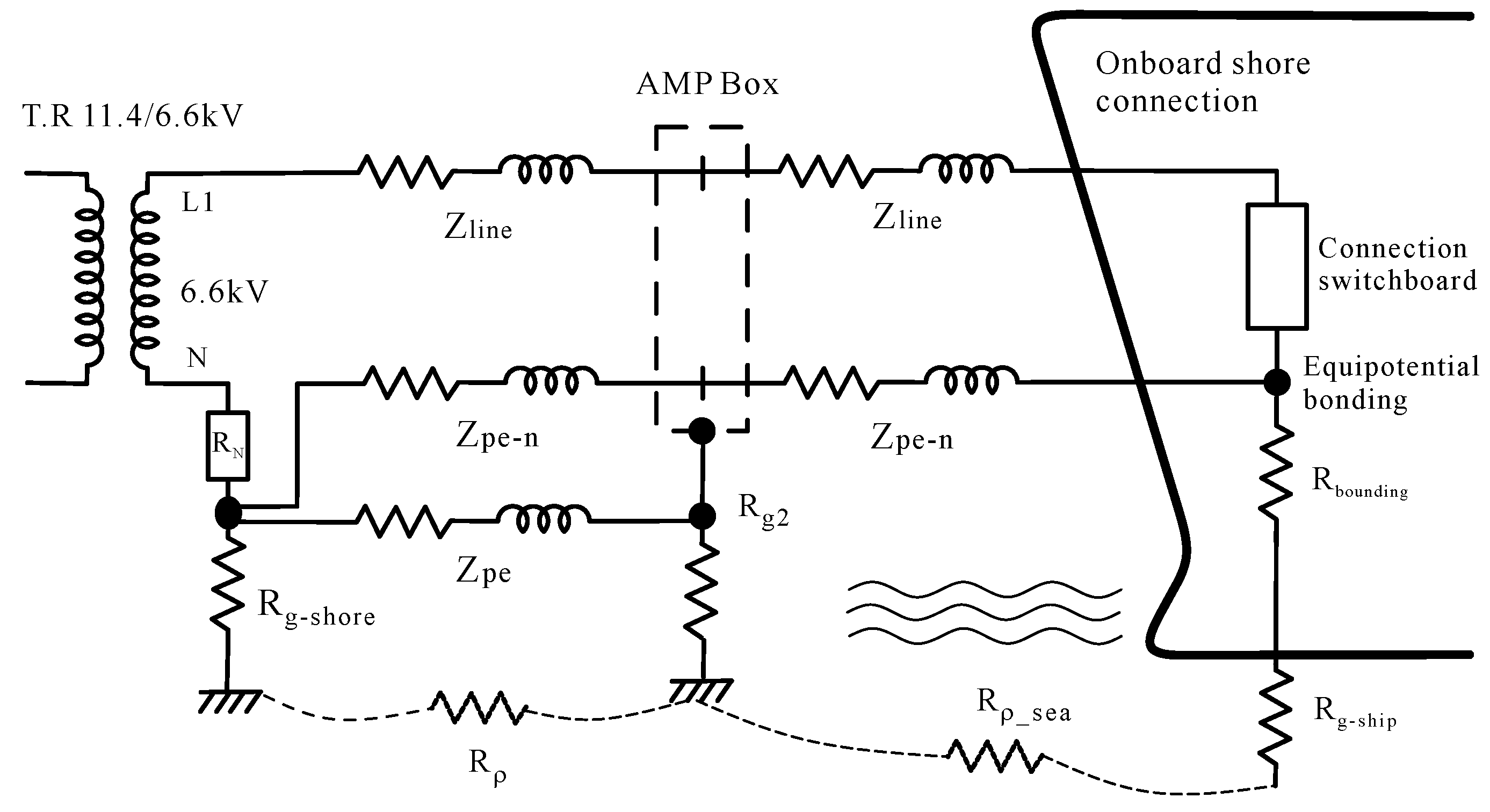

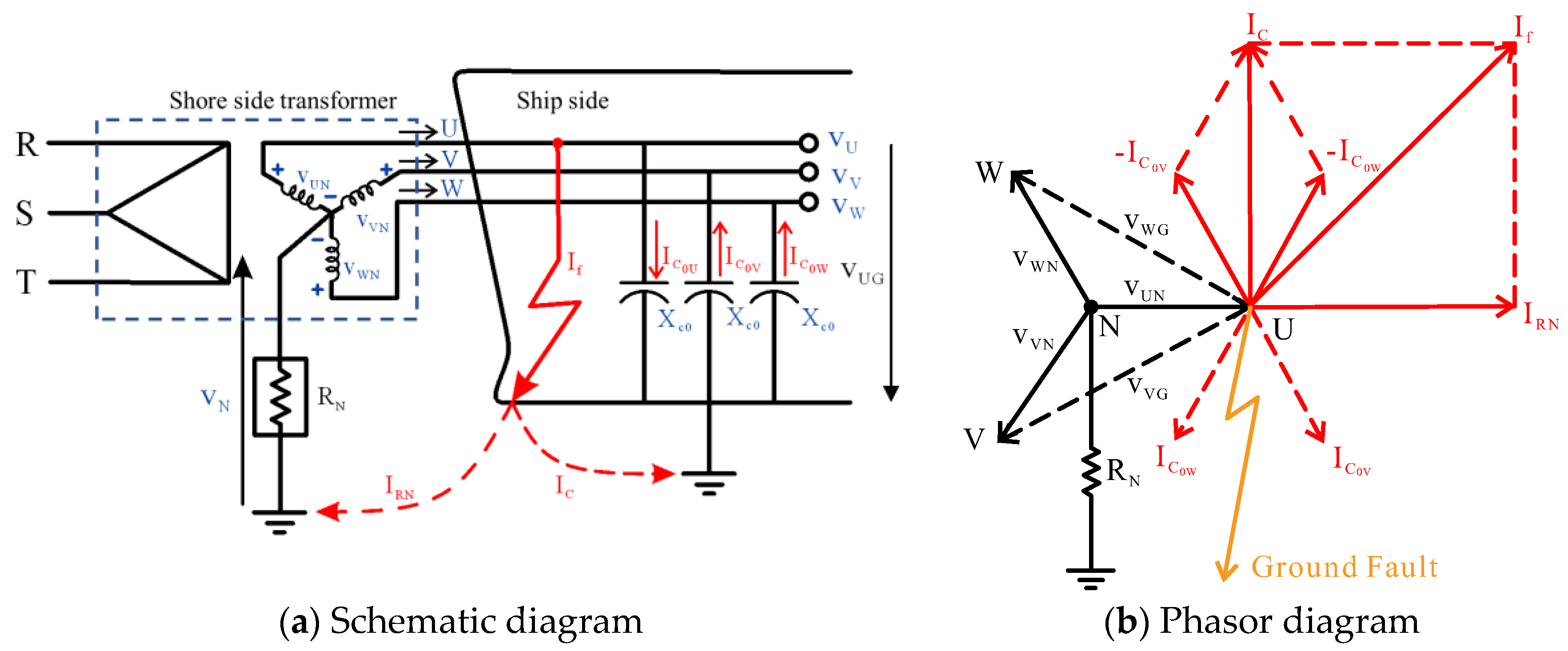

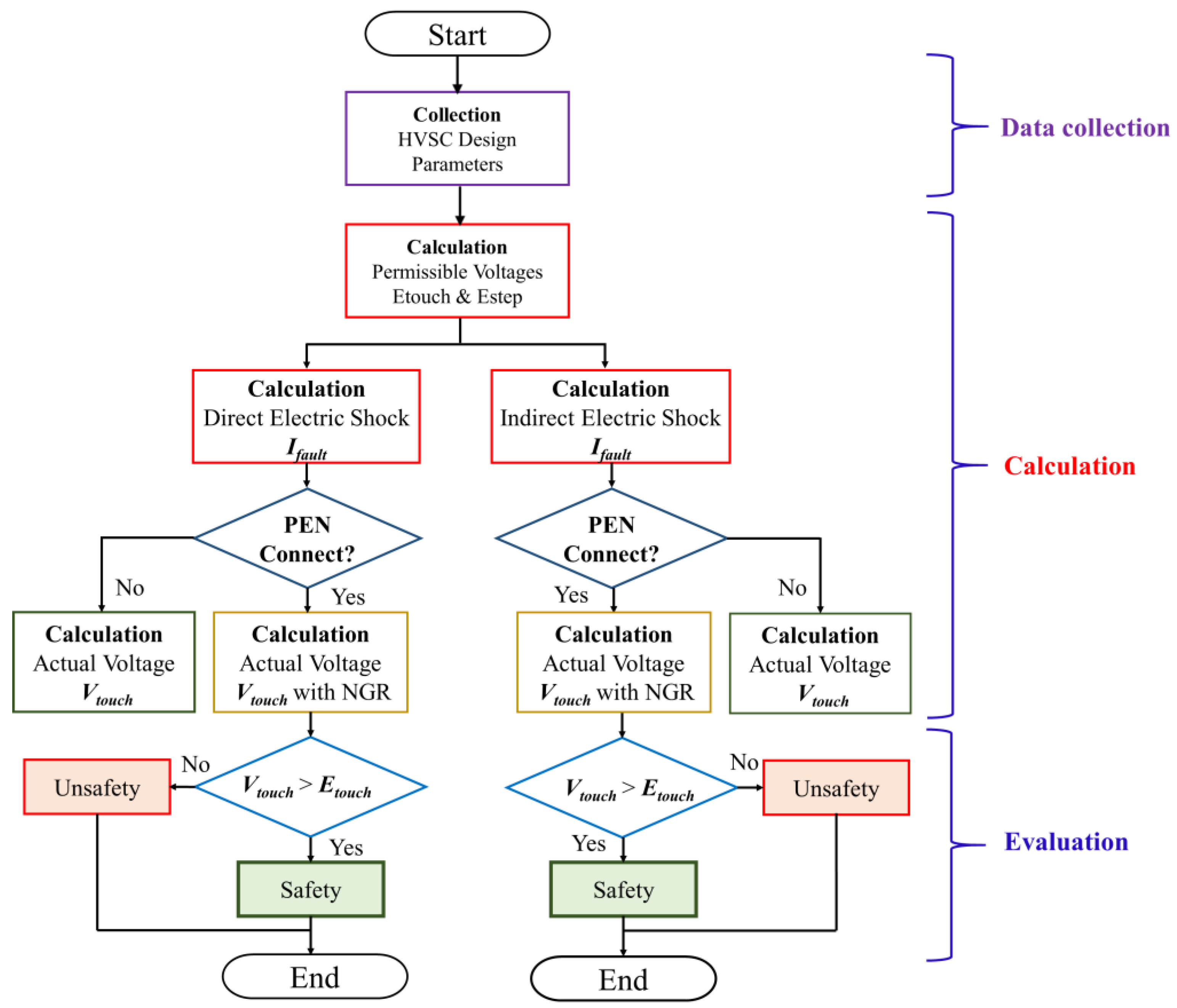
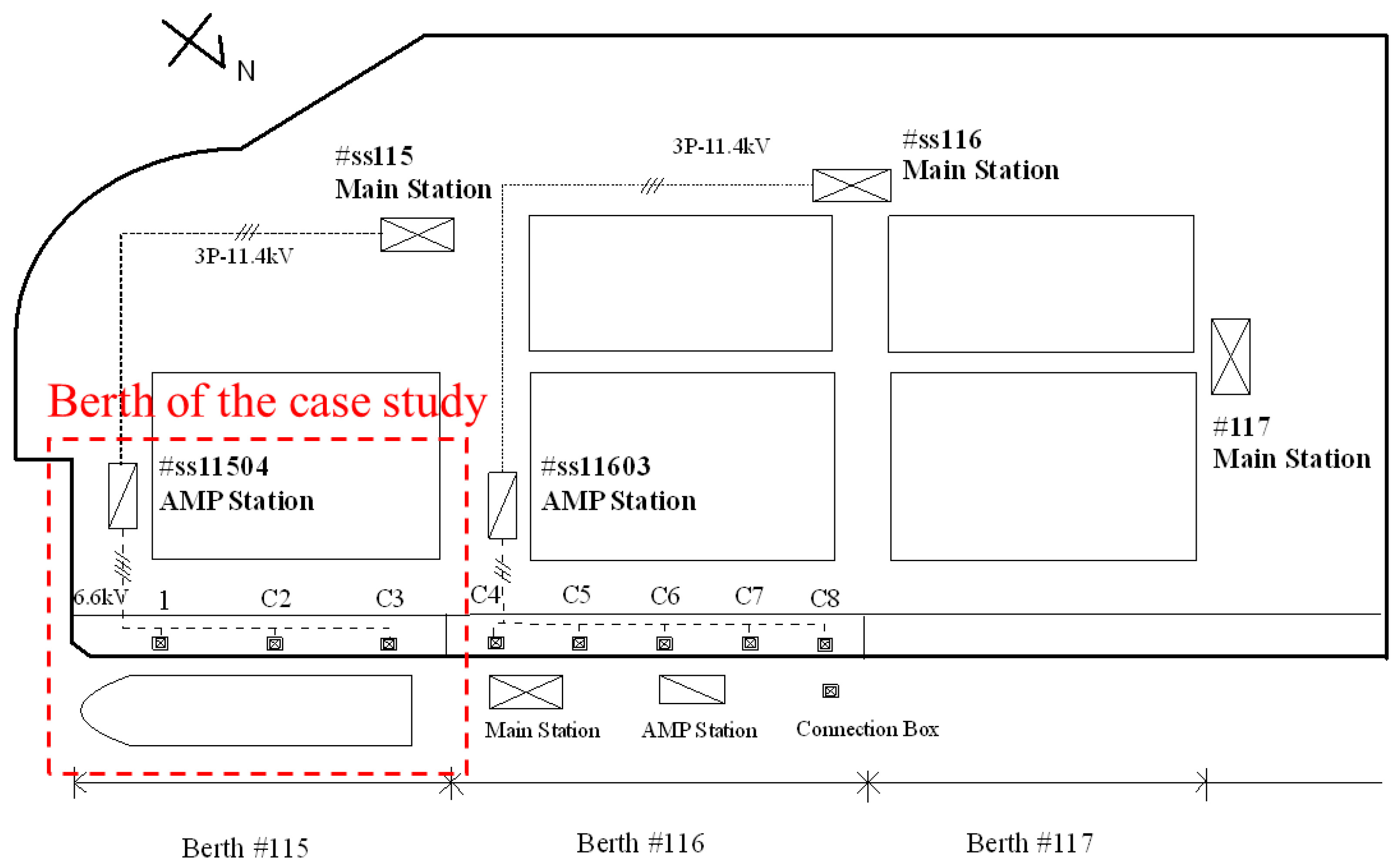
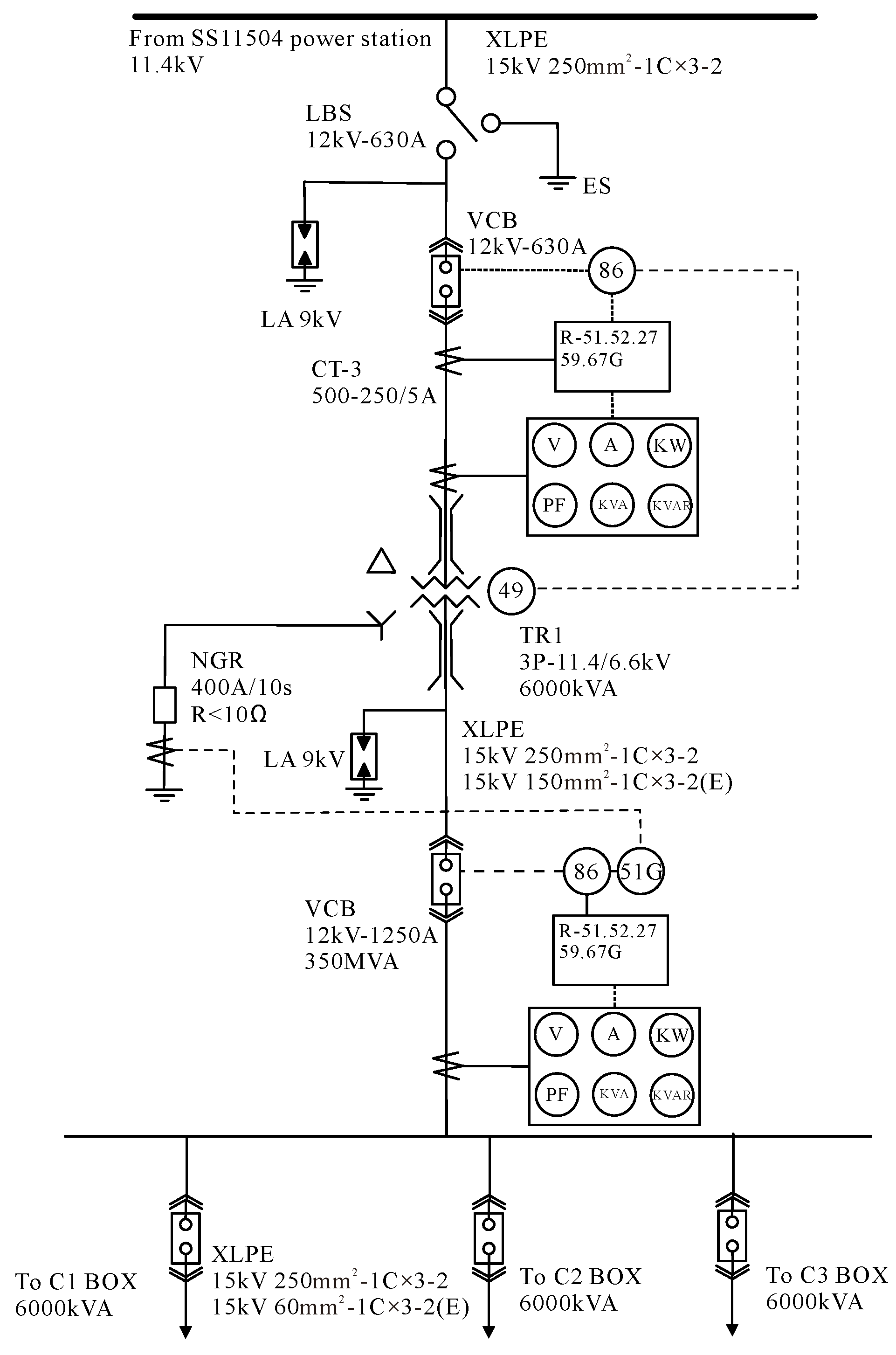
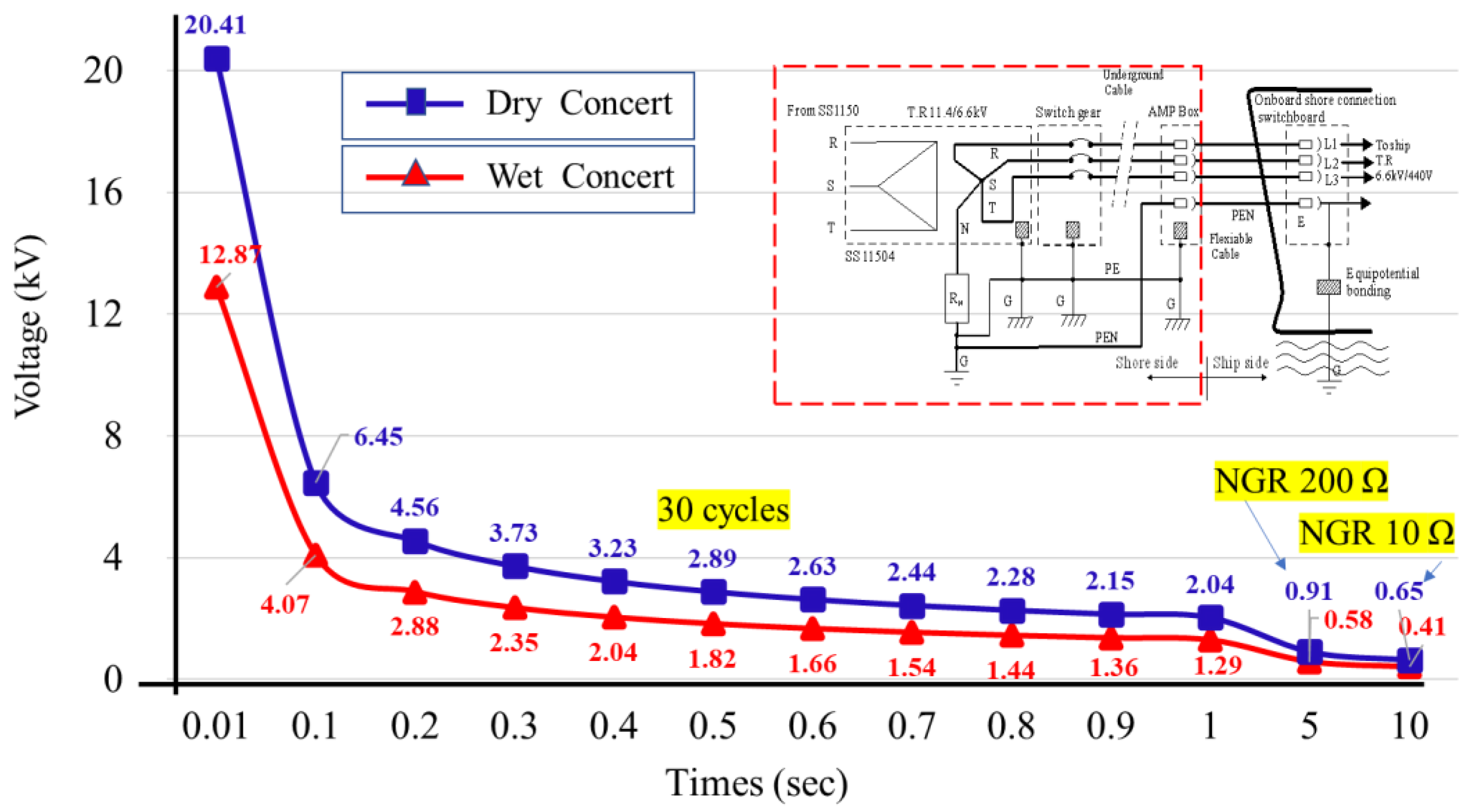
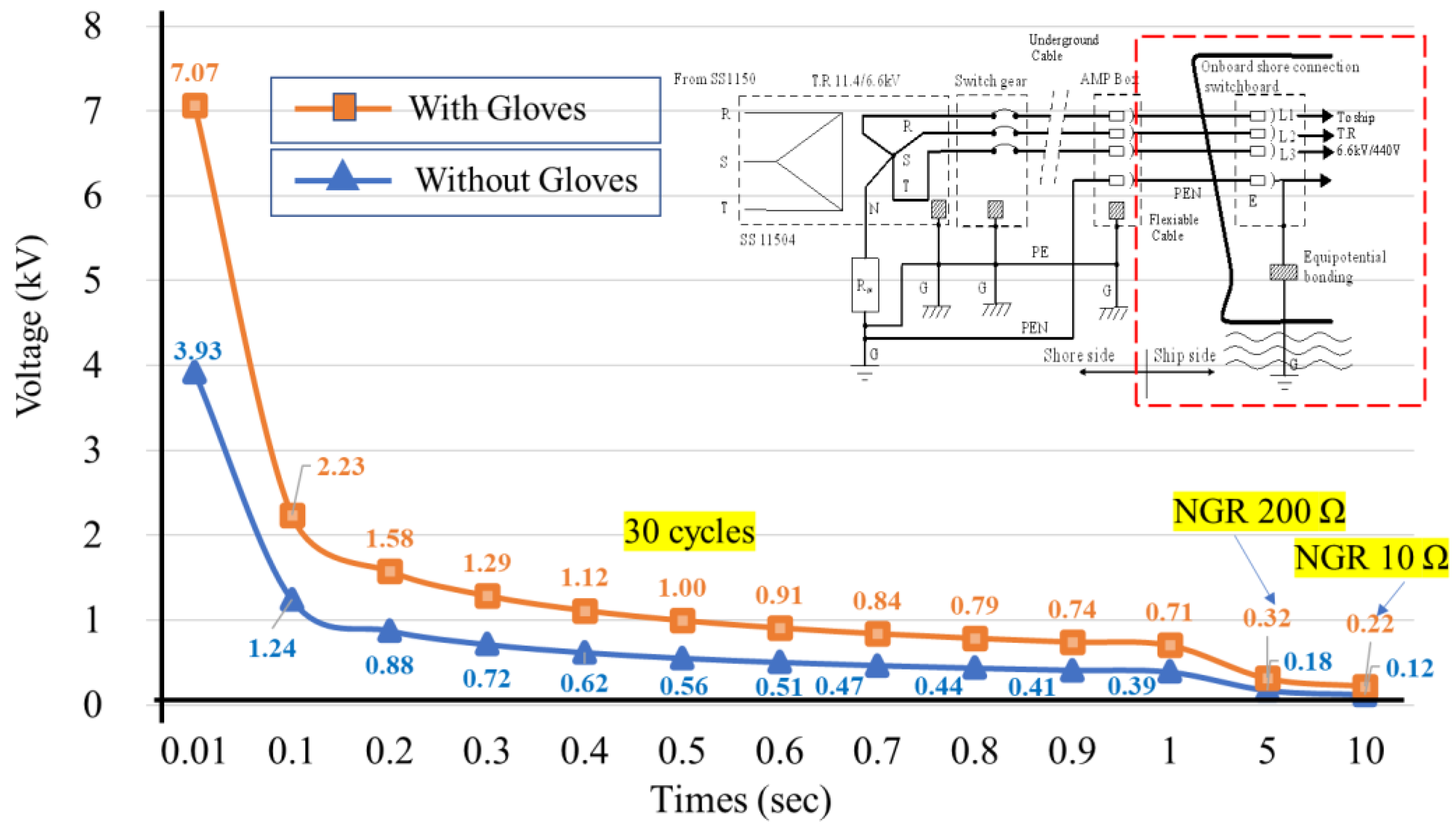



| Ship Type | Voltage (kV) | Power (MVA) | NGR (Ω) |
|---|---|---|---|
| Ro-Ro Cargo/Passenger | 11 | 6.5 | 335 |
| Cruise | 6.6/11 | 16–20 | 540 |
| Container | 6.6 | 7.5 | 200 |
| Liquefied Natural Gas Carrier (LNGC) | 6.6/11 | 10.7 | N/A |
| Tankers | 6.6 | 7.2 | N/A |
| Shock Duration (s) | Shore Side (V) (Wet Concert) | Shore Side (V) (Dry Concert) | Ship Side (V) (Metallic Desk) | ||||
|---|---|---|---|---|---|---|---|
| Estep | Etouch | Estep | Etouch | Estep | Etouch | Etouch (with Gloves) | |
| 0.01 | 12,784.00 | 4396.00 | 20,410.00 | 6280.00 | 10,990.00 | 3925.00 | 7065.00 |
| 0.1 | 4071.12 | 1390.14 | 6454.21 | 1985.91 | 3475.34 | 1241.19 | 2234.15 |
| 0.5 | 1820.66 | 621.69 | 2886.41 | 888.13 | 1554.22 | 555.08 | 999.14 |
| 1 | 1287.40 | 439.60 | 2041.00 | 628.00 | 1099.00 | 392.50 | 706.50 |
| 5 | 575.74 | 196.60 | 912.76 | 280.85 | 491.49 | 175.53 | 315.96 |
| 10 | 407.11 | 139.01 | 645.42 | 198.59 | 347.53 | 124.12 | 234.41 |
| Locations/Items | Shore-Side Substation to AMP Junction Box: 0.6 km | Ship-Side AMP Junction Box to Ship: 0.1 km | |
|---|---|---|---|
| Supply power | 11.4/6.6 kV 60 Hz | 6.6 kV 60 Hz | |
| Human resistance |
|
| |
| Soil resistivity |
|
| |
| Phase and neutral cable |
| ||
| Others |
| ||
| PEN Connect | NGR (Ω) | Ifault (A) | Shore-Side AMP Junction Box (V) | Ship-Side Receiving Panel (V) | ||
|---|---|---|---|---|---|---|
| Vtouch (Dry) | Vtouch (Wet) | Ib | Vtouch | |||
| Y | 200 (HRG) | 19.04 | 3628.96 | 3556.35 | 1.411 | 3528.06 |
| Y | 100 | 38.07 | 3717.47 | 3678.98 | 1.466 | 3663.75 |
| Y | 10 (LRG) | 377.39 | 3800.91 | 3796.81 | 1.518 | 3795.12 |
| Y | 0 | 39,282.70 | 3810.41 | 3810.37 | 1.524 | 3810.29 |
| N | N/A | 3675.17 | 3809.51 | 3809.09 | 1.523 | 3808.25 |
| PEN Connect | NGR (Ω) | Ifault (A) | Shore-Side AMP Junction Box (V) | Ship-Side Receiving Panel (V) | ||
|---|---|---|---|---|---|---|
| Vtouch (Dry) | Vtouch (Wet) | Ib | Vtouch | |||
| Y | 200 (HRG) | 19.00 | 8.17 | 8.17 | 0.00327 | 8.17 |
| Y | 100 | 37.91 | 16.30 | 16.30 | 0.00652 | 16.29 |
| Y | 10 (LRG) | 361.97 | 155.63 | 155.62 | 0.06203 | 155.06 |
| Y | 0 | 7230.52 | 3108.79 | 3108.65 | 1.16079 | 2901.98 |
| N | N/A | 2597.79 | 1116.93 | 1116.88 | 0.44453 | 1111.31 |
Disclaimer/Publisher’s Note: The statements, opinions and data contained in all publications are solely those of the individual author(s) and contributor(s) and not of MDPI and/or the editor(s). MDPI and/or the editor(s) disclaim responsibility for any injury to people or property resulting from any ideas, methods, instructions or products referred to in the content. |
© 2024 by the authors. Licensee MDPI, Basel, Switzerland. This article is an open access article distributed under the terms and conditions of the Creative Commons Attribution (CC BY) license (https://creativecommons.org/licenses/by/4.0/).
Share and Cite
Hsu, S.-H.; Tzu, F.-M.; Chang, W.-H.; Chen, Y.-D. Assessing High-Voltage Shore Connection Safety: An In-Depth Study of Grounding Practices in Shore Power Systems. Energies 2024, 17, 1373. https://doi.org/10.3390/en17061373
Hsu S-H, Tzu F-M, Chang W-H, Chen Y-D. Assessing High-Voltage Shore Connection Safety: An In-Depth Study of Grounding Practices in Shore Power Systems. Energies. 2024; 17(6):1373. https://doi.org/10.3390/en17061373
Chicago/Turabian StyleHsu, Shih-Hsien, Fu-Ming Tzu, Wei-Huang Chang, and Yi-Dong Chen. 2024. "Assessing High-Voltage Shore Connection Safety: An In-Depth Study of Grounding Practices in Shore Power Systems" Energies 17, no. 6: 1373. https://doi.org/10.3390/en17061373
APA StyleHsu, S.-H., Tzu, F.-M., Chang, W.-H., & Chen, Y.-D. (2024). Assessing High-Voltage Shore Connection Safety: An In-Depth Study of Grounding Practices in Shore Power Systems. Energies, 17(6), 1373. https://doi.org/10.3390/en17061373







